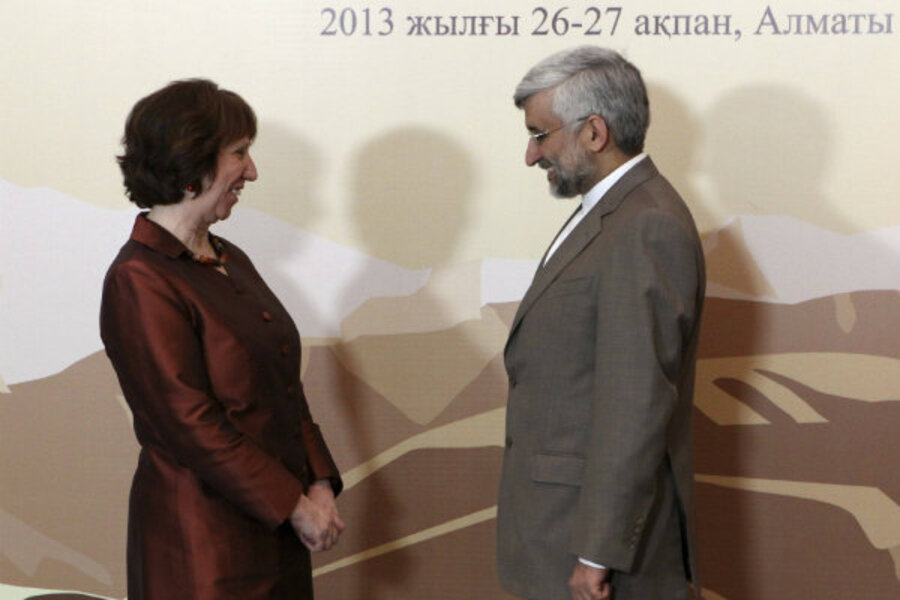Iran nuclear talks: Look to cooperation of US-Iran scientists
Loading...
| Annapolis, Md. and Oxford, Miss.
As talks about Iran’s nuclear program began today in Kazakhstan between the P5+1 (the five permanent members of the UN Security Council plus Germany) and Iran, many are doubtful that a suitable agreement will be reached. Relations between the United States and Iran present seemingly insurmountable challenges driven by more than 30 years of mistrust and missed opportunities on both sides.
Unfortunately, we cannot undo that history. However, we do have a choice either to ignore history – or benefit from its lessons. One of those often-overlooked lessons is the demonstrated success of ongoing, respectful collaboration between American and Iranian scientists, doctors, and public health experts. Such exchanges benefit the people of both countries and have the ability to cut through the deepest political and media-driven rhetoric. They offer a critical alternative to the vested interests of the extremist positions we now face.
Two examples of this include recent work in Iran with Iranians, Americans, Canadians, Europeans, and others from the Middle East and North Africa on HIV/AIDS research and education. That work culminated in the first international and fifth annual HIV/AIDS conference in Tehran.
The second example of American-Iranian citizen collaboration is occurring now in the Mississippi Delta, where Iranian doctors and public- health experts are helping adapt Iran’s highly cost effective, rural primary-care system to meet the health-disparity challenges in that impoverished region of the US.
The 2012 HIV/AIDS conference in Tehran was a collaborative effort of universities in the US and Iran, with speakers from the US and Canada invited to make presentations to participants from many countries, including Afghanistan, Kenya, and Pakistan, as well as the Britain and the US. Iran has been praised for the way they have responded to the HIV/AIDS epidemic in its country.
Mississippi, according to the United Health Foundation, is the unhealthiest state in the US. For decades, health disparities between impoverished and more well-to-do citizens in the Delta have been similar to those in developing countries. Over 20 years, Iran’s public health system virtually eliminated health disparities between the urban and rural population – and did so with minimal resources.
Research initiated in 2007 led to an assessment that the Iranian health-care model could be the much-needed paradigm shift for the Delta, as it would move from medically reactive “sick-care” to that of a proactive, community-based primary health-care system advocated by the World Health Organization.
The Mississippi-Iran rural health project was also a modest but important step to promote peace and better understanding between Americans and Iranians. The key to the project’s success is that it has reversed old patterns that always put Iranians into the position of inferiors seeking help. Now Americans are respectfully asking Iranians for help with one of our problems. From the Iranian point of view, the change is profound.
During a visit to a rural health center in Iran’s Fars Province, Iranian health-care workers said this American request was, in itself, “a miracle.” One worker, seeing the Americans, expressed it this way: “I always knew that rain fell down, but I never knew it could fall up.”
Despite the tensions and barriers, both sides participating in these ongoing humanitarian projects continue to demonstrate a willingness and openness to forge ahead in mutually respectful collaboration. For decades, such two-way scientific engagement has been the cornerstone of health and science diplomacy. Our current efforts follow in the tradition of the collaboration of Soviet and American doctors during the height of the cold war – collaboration that helped pave the way for treaties to reduce the threat of nuclear weapons.
More important, the US-Soviet exchanges provided a critical line of communication between the two sides at a time of suspicion and deep mistrust. This is a lesson from history that should be remembered, and applied today, by the US and Iran.
Ambassador John Limbert is the former deputy assistant Secretary of State for Iran in the State Department's Bureau of Near Eastern Affairs. A former hostage in Iran, he currently is professor of Middle Eastern studies at the US Naval Academy.
James Miller is managing director of Oxford International Development Group in Oxford, Miss., a global health research and consulting firm. In 2007, he initiated what has now become the Iran/Mississippi Delta Rural Health project.





